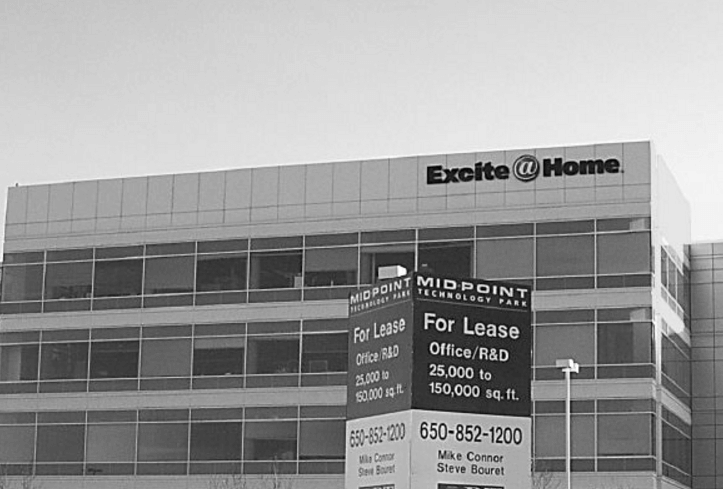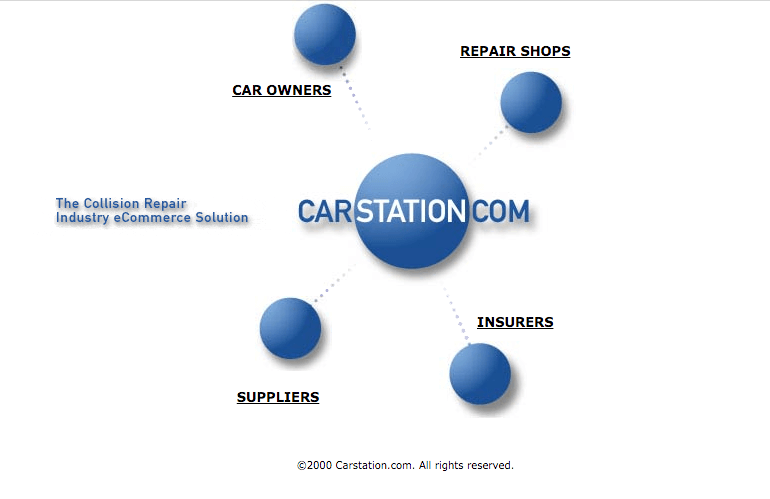tl;dr: Freelance journalist and editor Owen Thomas collects stories from the 2000-era tech bust. If you think that things are tough now, look back in time. This is nothing (so far).

Photograph by Mark Coggins, distributed under a CC-BY 2.0 license. Image has been cropped.
It was a March evening in 2000 in San Francisco. I can still picture the table at Ruby Skye, groaning with expensive fromage, attended by a Scandinavian cheese sommelier who was eager to have me try a slice of fudgy, salt-caramel gjetost. The founder assured me that the evening cost a pittance of the $20 million his company had just raised.
The Nasdaq crashed later that month. I have lived in fear of cheese sommeliers ever since.
The problem with bubbles and busts is that it’s hard to detect them when you’re deep inside. It all looks like a shimmering wall.
In 2000, people held pink-slip parties to celebrate their fat severance checks, confident that they would just move on to the next dotcom. Maybe B2C—business-to-consumer—was over. But B2B—businesses selling to other businesses—was set to take off, right?
I don’t know if we’re headed for a bust. One theory I have is that instead of big bubbles and big busts, we’ll have recurring froth. The low cost of starting a business combined with the fast Darwinian sorting power of the market means that money will slosh from one microsector to another, inflating one area and then another and then another.
So we may never see anything exactly like the dotcom bubble again. It arose in some unique circumstances—first, there was the runaway growth of the Internet in the ’90s. Add the Y2K bug: The Federal Reserve pumped liquidity into an already frothy market to ease fears of disruption as the clock ticked over to 2000. Corporate IT staffs were stretched thin upgrading old software code, which meant that CEOs eager to get their companies online hired new-economy consultants like Scient, Viant, and Zefer, whose payrolls ballooned into the thousands, fueled both by big billings and blockbuster IPOs.
I remember standing in Pac Bell Park — this was before SBC bought Pacific Bell and before it bought AT&T and took its name — at the launch of eCompany Now, a long-forgotten title launched by Time Inc. in its eagerness to get into the tech-magazine game.
The Barenaked Ladies were playing. “I met you before the fall of Rome,” the band sang. The band knew the score.
I can rattle off theories about what caused the boom and the bust all day long. But none of those will help you understand what it was like to live through it. Sit back while myself and a few friends tell you stories of what the bad old days were like. (First-person anecdotes have been condensed and edited for your pleasure.)
945 Bryant Street, San Francisco, Pets.com HQ
On a Tuesday morning in November 2000, Mylene Mangalindan, then a reporter for the Wall Street Journal, watched employees file into Pets.com’s headquarters at 945 Bryant Street in San Francisco.
They would soon learn that they were out of work, and that Pets.com was out of business. Security guards kept Mangalindan from entering the building. Pets.com CEO Julie Wainwright picked up the phone and angrily shouted at a colleague of Mangalindan’s. Wainwright, who had eagerly courted the press during Pets.com’s brief time as a dotcom darling, was now miffed that Mangalindan was doing her job.
“They asked me to leave, so I left the building, but I stayed outside, because the sidewalk is public property,” Mangalindan told me.

Image via Flickr user Johnny Ryan under CC BY 2.0. Image has been cropped.
Nine months earlier, Wainwright had spent millions of dollars on a Super Bowl ad — Pets.com’s second time advertising in the big game. Michael Ian Black, the voice of the Pets.com sock puppet, sang “Three Times A Lady” to Diane Sawyer on Good Morning America. (ABC’s parent company, the Walt Disney Corporation, had a big stake in Go.com, which in turn had invested in Pets.com.) That same month, Pets.com went public at $11 a share.
In its brief history as a public company, Pets.com never returned to that price. Not enough people were online yet; dog food and kitty litter were expensive to ship; and Pets.com’s mass-market advertising strategy was inefficient — it didn’t target pet owners. On top of those self-inflicted wounds, Pets.com faced a host of copycat competitors.
Two months after Pets.com’s ignominous shutdown, its landlord confidently announced it had found a new dotcom to rent the place at a rent 50% higher than what Pets.com was paying. Pets.com now redirects to Petsmart.com. Pets.com founder Greg McLemore is selling scented candles on his website.
44 Montgomery Street, San Francisco, Xpedior Offices
Edith Harbaugh, now CEO of LaunchDarkly, was among the army of consultants who came to San Francisco to build websites. Here’s her story:
“I moved to San Francisco in 1999 and was being billed at $200 an hour, fresh out of college, by Xpedior. We had a box at Pac Bell Park and a thriving business. Then VC dried up, and with it our customer base. I remember coming in one day and our office coffee machine had been repossessed for not paying our bills.
People had ordered catering from the Starbucks downstairs and then the company stopped paying bills. So Starbucks employees would sometimes yell at people if they recognized them.
BusinessWire moved into our old Xpedior office. An Xpedior coworker, Gilbert Vahanian, joined BusinessWire, and the joke was that he’d find our old spatulas in drawers.”
Xpedior was just one of many dotcom consultancies to spring up during the bubble. Harbaugh later joined a software company, Epicentric, which occupied space hastily vacated by Scient, which had decorated the space with gaudily colored carpet. Salesforce later moved into the building, and Harbaugh recalls seeing the same 2000-era carpet, now dingy, in the building in 2011.
Xpedior is now a baby-stroller brand.
330 Townsend Street, San Francisco, CarStation.com HQ

After learning Java as a software engineer in the ’90s in Ohio, Michael Kovacs moved to San Francisco in 2000 to join CarStation.com, a company which promised to connect auto dealerships and parts suppliers electronically. The company had just raised $32 million from Goldman Sachs. Here’s his story:
“I quickly discovered that millions of dollars of VC money had been set ablaze on Sun, Oracle, and WebLogic technology all sitting idle since we had very few customers but were provisioned like a Fortune 500 company. An expensive team of contractors from Scient that learned how to write code on the job created the sauciest JSP/JDBC spaghetti code I’d ever seen.
The engineering lead had a nervous breakdown, in the office, and was escorted out by his family who came to pick him up. I never saw or heard from or of him again. I truly wonder what happened to him.
Finally the meeting came where they split the company into two conference rooms. Charlie Moore, the president, an attorney always dressed in a sport coat and slacks with a strong salesy disposition, announced the company was moving to LA and those of us in this room were being offered jobs. The folks in the other room were all being let go that day. Needless to say it was fairly uncomfortable once those two rooms emptied out.
I didn’t take the offer, stayed in SF and had a job a week later at BEA Systems where I waited for the impending storm to pass.”
Before the layoffs, the company had an annual run rate of about $5 million, according to Bob Kirstiuk, who founded a company bought by CarStation.com. Kirstiuk repurchased his original business and the company sold the e-commerce system to a competitor.
Advertising agency Leo Burnett cited CarStation.com as one of the key accounts for its rapidly expanding San Francisco office in 2000. It closed that office in early 2001.
Kovacs went on to found LendingKarma.com.
BEA bought WebLogic, and Oracle bought BEA and Sun, which was nice for Larry Ellison. Except that no one spends millions on hardware and software anymore, because we have Amazon Web Services, which is nice for Jeff Bezos. CarStation.com appears to be a parked domain.
225 Bush Street, San Francisco, NBCi HQ
In May 1999, General Electric, then the owner of NBC, merged the network’s Internet properties with CNET’s search engine, Snap.com, and Xoom.com, a website-hosting company which had gone public in December 1998, to form a new, publicly traded entity called NBCi, with the goal of competing with Yahoo.
By August 2000, NBCi laid off 20 percent of its staff. In April 2001 — less than two years after creating NBCi — General Electric shut it down, laid off 85 percent of its remaining 300-person staff, and folded the remainder back into NBC.
NBCi CEO Will Lansing had a $4 million home loan forgiven — part of the pay package he’d negotiated when he joined the company. He’s now CEO of FICO, the credit-scoring company.
A new company called Xoom.com, unrelated to the old one, went public in 2013 and was bought by PayPal last year. Snap.com is a GoDaddy-parked domain. NBC is now owned by Comcast.
413 Pine Street, Seattle, Rivals.com HQ
In 1999, a network of sports sites called Rivals.com lost $21.4 million on sales of $1 million. It nevertheless raised $75 million in venture capital and in March 2000, it filed for a $100 million IPO. The IPO never happened.
By August 2000, it was laying off employees and cutting back on plans to expand into entertainment and politics. Even as it laid people off, though, it was still hiring people. One of them was Steve Calderon. This is his story.
“I was 25 and it was my last day at my job. I’d accepted a QA position with Rivals.com. In two days I’d be getting on a plane and leaving the place where I’d gone to high school and starting new adventures. As I was getting up from my chair to go with my coworkers to my going away lunch, my desk phone rang. The caller ID showed a 206 number. Seattle. I picked up. It was Mark, my new boss. He wasn’t the manager of my group two weeks ago when I’d interviewed for and accepted the job, but that guy was gone now. Mark had started a few days earlier.
‘Hey Steve. I just wanted to warn you that you might see Rivals in the news today. We’ve laid off about 75% of the staff. Don’t worry; your job is still safe. I just didn’t want you to panic if you read about us today. We’re all still really looking forward to having you join us on Monday!’
Almost immediately after I hung up the phone, it rang again. It was the car moving service Rivals had hired for me confirming my appointment for the next day.
‘Pick any of the cubes in that area; they’re uh… all available,’ Mark told me as he showed me around a very large, mostly empty floor. A few rows away, someone from human resources and someone from IT were going through cubicles with a cart, picking up equipment and office supplies left behind by the former occupants. ‘It’s a little quieter than usual today. A lot of the team are in Hawaii for the Hula Bowl. We’re the primary sponsor!’
As I set up my desk and computer, I watched a guy set up a table of free sandwiches, salad, and fruit for lunch. Mark came by at around 11:30 with what remained of my new team to take me to my welcome lunch.
A few months later, in early 2001, our CTO summoned us all to an empty floor in the building for an all-hands meeting. I’d met him once, during my interview. When I’d asked him how the company made money he told me, with a straight face, ‘We don’t need to make money; we have venture capital!’
He now stood on at the front of the room with a microphone and confirmed what many of us had already read on FuckedCompany.com earlier that morning: We had reached the end of that venture capital and all the rest of our cash. Today was our last day. Shut down the servers, turn off the lights, and we’ll see you across the street for a pint. Welcome to the club.”
Rivals.com shut down in 2001. An investor group bought its assets, relaunched the site, and eventually sold it to Yahoo in 2007.
54 Canal Street, Boston, Voter.com
Kevin Callahan was the first engineering hire at Voter.com, a news and information portal that raised $15 million and hired contributors like Tucker Carlson and Carl Bernstein. Voter.com made headlines throughout 2000 as it covered the elections—and then abruptly shut down after failing to raise an expected financing round. Here’s Callahan’s story:
“[Voter.com CEO] Justin [Dangel] had enough in the bank to pay us through February. The engineering team would shuffle in and punch out our minor tasks for the day — mainly maintenance. We had nowhere else to go so we’d all come in, peruse job sites, applying for gigs, waiting for some miraculous news that Justin and the team found a last-minute investor.
At noon (sometimes earlier) we’d do a beer and pizza run. We’d stick the cases of beer outside the window and fire up the quake server. Quake, beer, pizza — and looking for your next job between being pwned. We did that for two or three weeks before the doors were locked.”
Callahan went on to cofound MapMyFitness.
Voter.com provoked complaints when it tried to sell its data, including users’ political affiliations. Its website is offline and the domain appears to still be registered in the old company’s name.
650 Townsend, San Francisco, TechTV HQ
TechTV was a cable channel spun out of tech publisher Ziff-Davis and backed by Microsoft cofounder Paul Allen’s Vulcan Ventures. In April 2001 — a year after the Nasdaq began its long descent — it started broadcasting nine hours a day of live programming. Cathy Brooks was TechTV’s director of guest booking. Here’s her story:
“In the first couple of months of operating TechTV Live, we blew out over a year’s budget in satellite — it was well into the tens of thousands of dollars.
The day of the mass layoff was dark. It was as though the air had been sucked out of the building. I’d been told of the cuts. I went in to work that morning prepared to lay off a number of my staff in the booking department. I was called into the office of my boss, Jim Louderback. He told me to close the door. I remember the look on his face — pale, constricted.
He asked me to sit down and informed me that the cuts had to go deeper than planned. That in a board meeting the night before Paul Allen had pretty much ordered (something about yelling and pounding the table) that the cuts had to be deep or they didn’t count.
Jim was informing me that I was being let go. He was so upset. I felt numb. I went back to my office and began to gather my things — TechTV and ZDTV paraphernalia, pictures, and an amusing statue of Godzilla that had been sitting behind my computer. I put it all into a box and opened my office door.
I remember stopping for gas on the way, and suddenly bursting into tears at the gas pump. There was a homeless guy sitting nearby panhandling. He watched me for a few minutes and said, ‘Honey I’m not sure what happened to you, but I can tell you that whatever it is, one day you’ll be grateful for it.’ He was right. :) [Editor’s note: This is the last smiley that Mattermark will publish.]”
After working in tech for another decade or so, Brooks recently moved to Las Vegas to start the Hydrant Club, an off-leash social club, daycare, and boarding service for canines.
TechTV was bought by Comcast, kicking off a series of events which gave us Kevin Rose.
—
Editor’s note: Nothing new under the sun.